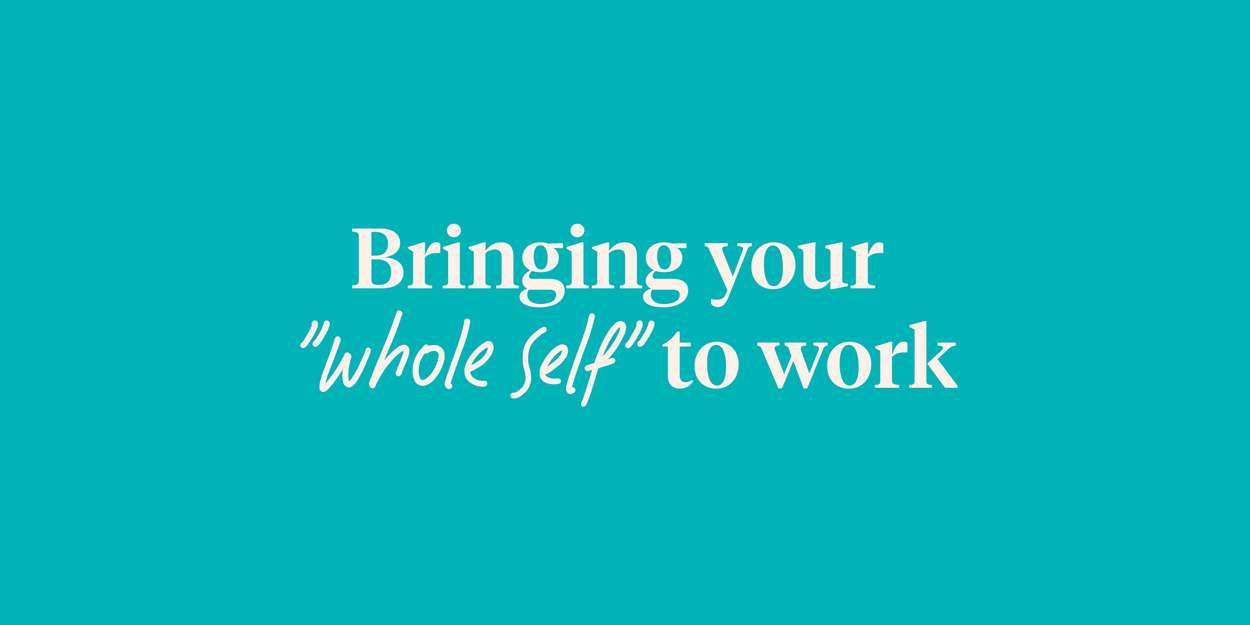
To begin, what is "your whole self?"
This concept of a "whole self" can be as amorphous as defining workplace culture.
Bringing your whole self to work means bringing all components of what makes "you" to the workplace. This could mean working at a place where you are encouraged to express yourself through what you wear, empowered to lead a workshop on your cooking skills, or have a flexible work schedule to care for family, among other things.
Buffer’s Ash Read explores this concept in a fascinating and honest blog post, “What Does It Mean to Bring Your ‘Whole Self’ to Work?” He says, “Wholeness means we bring all the elements of who we are to work – our passions and strengths, our side projects and relationships, our partners and kids.”
Bring your whole self to the interview
Even before you accept a job offer, you can use the interview process as a time to figure out if your whole self will be accepted. It’s also a time for the company to see if they really want all of you.
At ThoughtSpot, CEO Ajeet Singh interviews not just the candidate, but their family as well (if they’re interested). As Rachel Sugar reports in Business Insider, his view is based on personal experience with his family. He says, “Making career choices is a joint decision between my wife and me [...] And I believe all spouses and children will play a part in ThoughtSpot's long-term plan."
Part of the motivation for meeting a family member or two is for Ajeet to assess whether ThoughSpot can “support their goals outside of work” and show the family that ThoughtSpot cares for employees' wellbeing. Ajeet points out what many people may be thinking at this point: “The idea of your CEO meeting your husband before the paperwork is signed takes the blurring of the personal and the professional to the next level.”
However, is it that weird to involve your family in the interview process? They are, in many cases, greatly affected by our career choices. It’s an optional addition at ThoughtSpot and one that Ajeet and his company have found to be successful. Ajeet says, "In every case where [the spouse] agreed to the meeting, afterward they were glad they did." Ajeet finds that families feel “more comfortable with the company” after this interview process.
Not many companies have adopted Ajeet's interview style yet, but the Harvard Business Review provides information on how to tell your whole story during an interview in a piece by Lara Galinsky. Lara says that during an interview, “We typically tell our professional stories beginning with our first job. After all, that’s what’s on our resumes and so it’s the narrative we tell ourselves and others about our work life. But that’s not when our stories begin [...] Your story didn’t start with your first paycheck.”
In a session Galinsky led, called "Purpose at Work," she asked participants to “reflect back on a time when work and play were not always distinguishable [...] What were they drawn toward before they, their family, or teachers started put boxes around their identity?”
Essentially, what would you do if you wanted to bring your whole self to work?
You can have half of me
The arguments against the “whole self” philosophy point out that it can be oppressive if not executed properly. Maria Guzzetta for Inc. says with emotion, “Dear God, why? If marriage has shown us anything, it's that sharing one's whole self for extended periods often leads to resentment. The office is supposed to be one of the places people can still get a break from their whole selves.”
Another pitfall cited by Guzzetta, unearthed by Susan LaMotte, founder of workforce consultancy Exaqueo says: “The reality of whole self policies is often that companies expect people to bring their whole selves to the workplace because they're not giving them reasonable time to live a whole life outside of it.”
“The reality of whole self policies is often that companies expect people to bring their whole selves to the workplace because they’re not giving them reasonable time to live a whole life outside of it.”
Susan LaMotte
Founder of Exaqueo
In order to bring your whole self to the workplace, you need to fully embrace who you are. A workplace that acknowledges bringing your whole self to work doesn’t mean signing your soul over on the dotted line is important too. Your whole self is still entitled to privacy and some time off.
Can your workplace support your whole self?
Let’s say we’re ready to bring our whole selves to work; the next step is making sure our workplace supports this mindset. It’s the proverbial “which comes first” dilemma - a supportive workplace or our own desire to be ourselves wherever we are.
In an article for Triple Pundit, Sherrell Dorsey explores this idea with Diversity and Inclusion strategist James Wright. Sherrell says that business leaders need to create an environment in which employees feel comfortable expressing themselves.
Part of how this is done is with data: “By knowing what the workforce will look like from a data standpoint, companies can actively develop strategies and programming to engage and support employees beyond tokenism and work to provide a supportive platform to create a thriving workplace environment where employees feel safe to bring their entire selves to the table,” Sherrell says.
Sometimes our workplaces might be fully accepting of people's "whole selves," but most aren't quite there yet. James points out that “some leaders don’t fully bring themselves to their work environment until they have reached the C-Suite level. At this juncture, they have proven themselves, acclimated to the environment, and are now in a position of power where they can slowly become more open and comfortable sharing their true selves.”
For example, in 2014 after Apple CEO Tim Cook shared his personal essay in Bloomberg he became the first openly gay Fortune 500 CEO. He says, “Throughout my professional life, I’ve tried to maintain a basic level of privacy [...] Plenty of colleagues at Apple know I’m gay, and it doesn’t seem to make a difference in the way they treat me. Of course, I’ve had the good fortune to work at a company that loves creativity and innovation and knows it can only flourish when you embrace people’s differences. Not everyone is so lucky.”
In addition to sexual orientation, bringing your whole self to work can be a challenge for people of different racial and ethnic backgrounds. In a recent Fortune article, “An Inside Look at What's Keeping Black Men out of the Executive Suite,” interviewers revealed that many of these men “spoke of having to constantly calibrate their public miens: striving to appear focused at the office but not too aggressive; hungry but not threatening; well dressed but not showy; talented but not too damn talented.”
This frustration is expressed eloquently by Blavity co-founder Jonathan Jackson, and his advice to companies is:
“Get the uncomfortable feedback before you need it. Don’t think about the spaces everyone exists in; think about the ones people don’t talk about. It’s not necessarily safe to share what life is like outside the office, but we inevitably bring it in with us. Saying your environment is welcoming is one thing; making space for what it could be is another.”
Jonathan Jackson
Co-founder of Blavity
Yes, you can bring your whole self to work
It’s not cut and dry, but the answer leans towards yes - we can bring our whole selves to the workplace if we work in an environment that supports us and we embrace all that makes us unique. Motivational speaker, coach, and author, Mike Robbins has devoted the past 15 years to understanding essential human experiences in the workplace. In an article follow up to his Tedx Talk he sums it up:
"For us to thrive professionally, especially in today’s world, we must be willing to bring our whole selves to the work that we do. And, for the groups, teams, and organizations that we’re a part of to truly succeed, it’s essential to create an environment where people feel safe to bring all of who they are to work."






